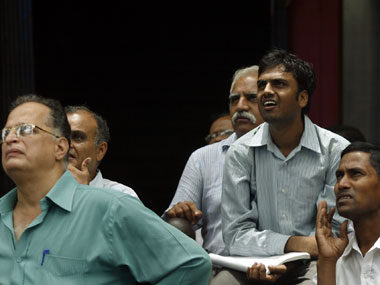The western world has always been fascinated by the rope trick where a man with a flute drives up a rope from a basket. They like to believe in the magic of the rope trick as India is seen as an exotic country with magicians everywhere.
The rope trick effect is now working on FIIs who are wholeheartedly embracing some announcements made by the government from an eight-year slumber.
FIIs have driven up Indian equities as they bought around $7 billion over the last three months.
Indians, on the contrary, do not believe in the rope trick. During the same period, domestic institutions have sold $3.5 billion of equities. Investors have been withdrawing money from mutual funds even as the Sensex rallied from the lows witnessed in May 2012.
The rope trick has turned the gloom and doom forecasts that prevailed in the markets a few months back into bullish ones. The Sensex is now seen breaching 20,000, as against the earlier prediction of 15,000 and below levels.
[caption id=“attachment_481662” align=“alignleft” width=“380”]  FIIs are viewing India as a market that has not done much in five years, with the Sensex giving hardly any returns in the 2007-12 period.[/caption]
The former is more plausible than the latter, given the Sensex is just 1,000 points, or 5%, away from 20,000. The index has given about 18 percent returns in its journey from 16,000 levels in May 2012 to the current levels.
The rupee has also seen a sharp reversal in fortunes as it is projected to hit 48 compared with the earlier predictions of 60 against the dollar. The rupee had touched record lows of 57 and above in June 2012 and has rallied over 8.5% since then due to the rope trick.
The question is who will laugh all the way to the bank? The FIIs, who are pumping in money, or the Indian, who is taking out money? The average Indian on the street knows that reforms announced by the government are not going to turn around his way of living with issues of inflation, corruption and poor basic infrastructure dominating day to day lives.
The Indian investor, who is taking money out of the markets, is looking at the rope trick announcements with skeptical eyes and he or she is not going to rush to the markets in a hurry unless there is a perceived change on the ground.
The FII, on the other hand, is flush with cash doled out by the US Fed, ECB and BOJ. FIIs are viewing India as a market that has not done much in five years, with the Sensex giving hardly any returns in the 2007-12 period.
The rupee is at close to all time lows and the government bonds at 8% yields on the ten-year bond are trading at a healthy spread over the cost of dollar funds (below 1%).
Cost of dollar funds is not going to rise any time soon as central banks have pledged record low rates for the next two to three years. FIIs do not live in India and hence from an outsider’s point of view India does look good on paper, given valuations are down.
The truth is that FIIs too do not believe that reforms such as FDI in retail, aviation, pension and insurance are going to push up India’s economic growth in a hurry.
The retail sector is plagued by high property prices, heavy competition from ecommerce and logistical inefficiencies. Aviation is hit by dithering policy makers who refuses to close down bankrupt airlines.
The NPS (National Pension Scheme) has hardly taken off even after four years of being in existence while most private sector insurance companies are yet to see healthy profits even after 10 years of operations.
Money goes after illusions first and then illusions turn to reality (a bit of it). Hence FIIs choose to believe the rope trick because they are given cheap money by their central banks and the Indian government is playing the cards right at the moment.
The Indian investor sees through the illusions and does not invest but when markets trend higher and higher, he or she will start believing in the illusion of a growing economy.
The FII will make the money first and the Indian investor will make money later but the one who can take profits first is the winner.
Arjun Parthasarathy is the Editor of www.investorsareidiots.com a web site for investors.


)
)
)
)
)
)
)
)
)



